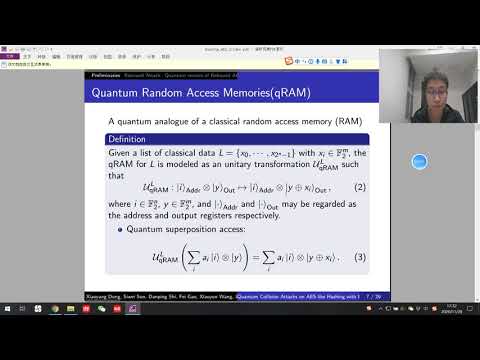CryptoDB
Quantum Collision Attacks on AES-like Hashing with Low Quantum Random Access Memories
| Authors: | |
|---|---|
| Download: | |
| Abstract: | At EUROCRYPT 2020, Hosoyamada and Sasaki proposed the first dedicated quantum attack on hash functions -- a quantum version of the rebound attack exploiting differentials whose probabilities are too low to be useful in the classical setting. This work opens up a new perspective toward the security of hash functions against quantum attacks. In particular, it tells us that the search for differentials should not stop at the classical birthday bound. Despite these interesting and promising implications, the concrete attacks described by Hosoyamada and Sasaki make use of large quantum random access memories (qRAMs), a resource whose availability in the foreseeable future is controversial even in the quantum computation community. Without large qRAMs, these attacks incur significant increases in time complexities. In this work, we reduce or even avoid the use of qRAMs by performing a quantum rebound attack based on differentials with non-full-active super S-boxes. Along the way, an MILP-based method is proposed to systematically explore the search space of useful truncated differentials with respect to rebound attacks. As a result, we obtain improved attacks on \aes-\texttt{MMO}, \aes-\texttt{MP}, and the first classical collision attacks on 4- and 5-round \grostl-\texttt{512}. Interestingly, the use of non-full-active super S-box differentials in the analysis of \aes-\texttt{MMO} gives rise to new difficulties in collecting enough starting points. To overcome this issue, we consider attacks involving two message blocks to gain more degrees of freedom, and we successfully compress the qRAM demand of the collision attacks on \texttt{AES}-\texttt{MMO} and \texttt{AES}-\texttt{MP} (EUROCRYPT 2020) from $2^{48}$ to a range from $2^{16}$ to $0$, while still maintaining a comparable time complexity. To the best of our knowledge, these are the first dedicated quantum attacks on hash functions that slightly outperform Chailloux, Naya-Plasencia, and Schrottenloher's generic quantum collision attack (ASIACRYPT 2017) in a model where large qRAMs are not available. This work demonstrates again how a clever combination of classical cryptanalytic technique and quantum computation leads to improved attacks, and shows that the direction pointed out by Hosoyamada and Sasaki deserves further investigation. |
Video from ASIACRYPT 2020
BibTeX
@article{asiacrypt-2020-30677,
title={Quantum Collision Attacks on AES-like Hashing with Low Quantum Random Access Memories},
booktitle={Advances in Cryptology - ASIACRYPT 2020},
publisher={Springer},
doi={10.1007/978-3-030-64834-3_25},
author={Xiaoyang Dong and Siwei Sun and Danping Shi and Fei Gao and Xiaoyun Wang and Lei Hu},
year=2020
}

